On Saturday, at 8:30PM, the Science Track filled Hilton 209–211 with eager fans for the “Lifeforms for Life in Space… Probably?” panel. Moderator Jamie Bernstein guided an energetic discussion with astrobiologist and author Dr. Seven Rasmussen, neuroscientist Dr. Brent “EvilPenguin” Roeder, and physicist Dr. Addie Dove. Together, the panel explored the tantalizing possibility of life in space.

Bernstein began the panel asking simply if life could survive in the vacuum of space? Rasmussen discussed a Japanese research team conducting a test with bacteria outside the International Space Station, and those bacteria have survived. Dove pointed out that tardigrades—microscopic organisms—survive in extreme environments and have even been carried on lunar payloads. However, Dove also pointed out that we look for signs of carbon-based lifeforms when searching for life in space or on other planets because all life on Earth is carbon-based. If there’s non-carbon-based life out there, we would not know how to look for signs of it.
Asteroids and comets, the panelists agreed, may be the best candidates for harboring primitive organisms. “We’ve found amino acids on asteroids,” Dove explained. “These are the building blocks of life.”
For life to thrive in space, Rasmussen outlined four essentials: amino acids to form proteins, a sturdy membrane to separate itself from the environment, an information system like DNA or RNA, and a way to metabolize energy. Photosynthesis, chemosynthesis, and even radiation-based metabolisms were all discussed as theoretical energy sources, with photosynthesis the most likely.
Roeder and Dove emphasized the challenge of heat regulation. Life generates waste heat, but space offers no easy way to vent it.
When the discussion turned to reproduction, Roeder suggested binary fission. He noted how in order to reproduce, life has to migrate. Dove suggested how the solar wind could help with this, first defining the solar wind as charged particles coming off the Sun. The solar wind could propel small organisms. Roeder jokingly suggested organisms might “burp” or “fart” to propel themselves.
The panel also explored communication. Sound is impossible in a vacuum. On Earth, some organisms use chemical or electrical impulse for communication due to being connected, but that won’t work in space. Roeder believed life in space would probably need some sort of visual communication.
Discussion eventually turned to humans. Radiation, gravity, and bone density loss remain formidable challenges. Dove noted that humans aboard the ISS lose bone mass despite heavy exercise. Rasmussen talked about a type of organism that lives in the Chernobyl reactor, a distant cousin of black mold. The organism absorbs and uses gamma radiation. If we could collect some of that organism and did studies, we could create potential organic shielding for humans. Long-term adaptations to low gravity could make humans taller or structurally different, but such changes would require many generations.
An audience member asked about silicon-based life. Rasmussen explained that while it’s a popular science fiction trope, chemistry makes it unlikely as silicon bonds too tightly with oxygen. “Carbon is statistically more probable,” Dove added.
